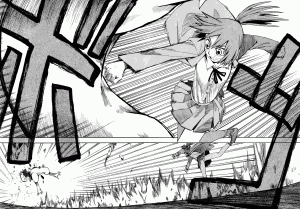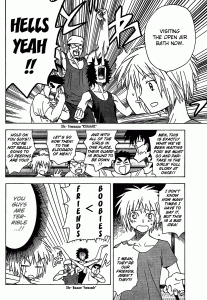This list is a little dis-honest. Well that’s not quite the right word for it; artfully structured? constructed? biased? In short this list may not be a true Top Ten of the manga I’ve read this year. Why is that? I hear you cry. Well quite simply because I didn’t want to put the same things on the list two years in a row. While I do largely write these things for my own self-satisfaction I do hold out the slim and naive hope that someone other than I actually reads them. As such I feel it would be something of a dis-service to not highlight as diverse a range as possible. After all, if I recommended a series last year and its still on-going (as over half of last years series are) then theres no reason to think it isnt worth your time.
So you should definitely take a look at Zettai Karen Children, Muhyo to Rouji no Mahoritsu Soudan Jumusou, Beelzebub, Until Death Do Us Part (Shi ga futari wo wakatsu made), The World God Only Knows (Kami no Mizo Shiru Sekai) and Nana to Kaoru. But if already have, or youre looking for something else then check out the manga listed below.
Well this is exactly a week over-due. I’m laying the blame for that entirely on the week and half I was “out” with the flu.
Berserk
(36 Volumes / 316 Chapters – Ongoing)
Ah Berserk. One of the first wave of anime I purchased when I got a full time job and still one of my favourites (it also has the greatest out-takes of anything ever). It was also was one of the first anime to introduce me to the kind of rage incomplete adaptation endings can evoke. Still, an awesome anime. At the time I wasn’t really into manga in a particularly big way, it was hard to get, expensive and online comics and scanlations were in their infancy. As such I resigned myself to never finding out what would happen to Guts and the Band of the Hawk.
It has been nearly a decade since then and in the interim I have re-watched the series more than once and I even came across the first volume of the manga on a scanlation site. But the artwork wasn’t great and the translation was so bad as to be actively off-putting. Of course what I didn’t know then was that that first volume had been drawn a somewhat staggering twenty two years ago. At the moment Berserk is still on-going and moving into its thirty sixth volume. Though I recently found out its slow pace is often due to the authors long hiatuses, one of which he took because, by his own admission, he was addicted to the game Idolm@aster and wanted to focus on it.
Still, his personal peccadillos aside Berserk really is a masterpiece. The intricacy and detail of the story are impressive without collapsing into a self-referential mess (looking at you Death Note). The plot and pacing are masterful, holding the readers interest and creating a near obsessive need to read more of it without resorting to cheap “tricks” like cliff-hangers and false reveals. The artwork, while admittedly a little ropey in the first volume, improves in leaps and bounds to its current impressive level of quality.
But really, it’s the characters and the world they live in that are they real selling point of the series. The characters, particularly the main ones, are endlessly engaging. Guts himself is without a doubt one of my favourite characters of all time and is perhaps the best expression of the anti-hero I’ve seen in any type of fiction. While the characters are in some-ways stereotypical they are all presented with enough skill (and rough edges) to make their “reality” a foregone conclusion.
The world itself is a grim and dark place where someone can be a hero simply for failing to succumb to the seemingly omnipresent darkness. The use of the world as a backdrop and a mirror of the events in the story is both subtle and well done. Contrasting the somewhat pastoral scenes, even during bloody battles, of the days when the Band of the Hawk was ascendant to the grim demon infested wastelands Guts trudges through as the Black Knight shows how the landscape acts a mirror to the state of the characters and the world. The world presented, which initially appears to be a typical medieval/renaissance Western Europe fantasy mash-up develops its own unique flavour and appeal as the story progresses.
Of course all these elements would be somewhat worthless if not held together by the fabric of a strong story. Luckily that is not the case here. The story presented in Berserk is excellent. It’s a nice unique blend of grim and realistic military action with dark fantasy. While there may be stories out there that share superficial similarities there really is nothing out there quite like this.
Plus look at the size of Gut’s sword, how could this not be awesome?
Hajime no Ippo
(94 Volumes / 923 Chapters – Ongoing)
As I mentioned above this year I got around to reading some of the “classics” that I had missed or ignored in the past and it’s hard to talk about classic manga without mentioning Hajime no Ippo. It has been running now for twenty one years. It’s currently in the middle of its ninety third volume and is over nine hundred chapters long. It’s also fucking awesome.
You can tell its fucking awesome because I read over nine hundred chapters about boxing. Boxing is a “sport”/martial art about which I would find it hard to care less. I find it tedious to watch, talk about or imagine. I also find attempts to glorify or give it a veneer of class literally laughable. However, I fucking loved Hajime no Ippo (and for that matter Katsu! wasn’t bad either). I suppose, like a lot of sports stories, the sport itself often serves as a backdrop for the inter-personal drama that drives the story forward.
In a way this feels quite similar to History’s Strongest Disciple Kenichi, both of them involve a main protagonist who spends a lot of time training to become strong and wondering about what being strong really means. Also like Kenichi the appeal of the series lies mainly in its cast. The characters and situations in Hajime no Ippo are much more realistic than the ones in Kenichi. Personally I find that to be fairly neutral fact, but I imagine some people may prefer Hajime no Ippo’s more “down to earth” style.
That’s not to say that the action in Hajime no Ippo is in any way boring, because its one of the more exhilarating reads out there. Just that the fights usually peak at an “action movie” level of realism rather than your more standard shonen level of realism. Of course as I know nothing about boxing that could be complete balls, but the training and matches themselves all ooze verisimilitude. Which is probably a word I use too much but really adds a weight and impact to a story that cannot be over-estimated.
While the action is the main draw for me the characters and their interaction, and individual stories (all of which are fairly well developed) is almost as appealing. The expanded cast, particularly the other gym members and support staff, are all as cool or entertaining in their own right as the protagonist. Another appealing factor is the humour seeded throughout the work. This provides a nice counterpoint to the more serious drama or action. There are also one or two, very understated, love stories. Which are nice in their own way, but are developed very slowly and sporadically.
Classics can often disappoint, but Hajime no Ippo never does. Reading it all in one huge chunk does make it nearly unbearable waiting for the slower “week to week” scanlations to come out.
Mirai Nikki
(11 Volumes / 59 Chapters – Complete)
I dislike “otaku culture”, especially when it’s appropriated by, well (much as I dislike the term) weaboo’s. I always find it baffling that people can’t simply take what they want or require from something without donning the trappings of its source. When I smoke a joint I don’t start talking like a stoner and get marijuana leaves tattooed on my balls (fuck me people who buy into stoner culture are even more annoying than weaboo’s) similarly when I watch, for example, K-ON! I don’t start talking about how fucking “moe” the characters are. That being said anime and manga is an outgrowth of Japanese culture and anime and manga otaku and their unique nomenclature and culture have become firmly enough established that newer texts are created either consciously with them in mind or are unconsciously influenced by them. As such it simply pays to be familiar with terms like tsundere,yaoi, moe, etc. Though I’d rarely use them unless calling out specific examples.
What the fuck does all this have to with Mirai Nikki? You may be (rightly) asking yourself. Well sometimes you stumble across examples of these various things that are so blatant and pure that you simply have to refer to them by their assigned otaku moniker. And Mirai Nikki has the most perfect example of a yandere that I have ever come across. She’s also one of the best things about the series.
So for those too lazy to click on the hyperlinked title above Mirai Nikki (lit. Future Diary) is the story of a lonely adolescent, Amano Yukiteru, who spends his time studiously avoiding contact with others. Segregating himself off from the rest of society he sets himself up as a “bystander” who writes about what he sees in his mobile phone diary. This is until he gets drawn into the plans of Deus Ex Machina, The Lord of Space and Time. Deus gifts Yukiteru with an “upgrade” to his diary. Now Yuikteru’s diary will record the future. The price for this upgrade is his forced participation in a competition to determine Deus’s successor.
I really, really like this series, from the setup to the characters to the terribly fucked up things that happen. Over the past year I’ve become very interested in the idea of what do you do when given power? An ordinary person in the real world is suddenly gifted with some kind of power or ability that sets them apart, what do they do with it? Why do they do these things? Questions like that have popped up in my idle thoughts time and again. Unfortunately there’s not a huge amount of stuff out there that directly addresses the situation in a manner which I like. Mirai Nikki comes very close, the “power” that the competitors gain, while potent, doesn’t raise them far enough above their fellow man to make basic conflict a joke (which is the case in most superhero settings) nor does it remove them so far from humanity (or at all really) that basic human relationships no longer matter. The world presented in Miarai Nikki is also fairly realistic, once you buy into the big lie of course.
All in all Mirai Nikki is an excellent read, the plot developments are generally surprising without feeling like crass sensationalism, the characters while somewhat larger than life all feel real, as does the world itself. The pacing is frenetic while still allowing the author to clearly present the psychological aspects of the participants (thankfully without falling into the wankery that “psychological dramas” often wallow in). The artwork ranges from good to excellent, and the scanlation quality is generally top notch.
As I mentioned above there is one oh so very crazy bitch in this series and while I really like the character, and her madness is conveyed in a way which makes it generally disturbing, some of the situations presented are heavy on ye olde gore factor. Not to a gore porn level (or gurro if you prefer you weaboo bastard), but as it’s often rather unexpected and rather realistic it can be a little disturbing.
PS: I have yet to read the final volume, so possibly it all goes to shit there. But even if it does it’s still worth reading the first ten)
Ao no Futsumashi
(5 Volumes / 18 Chapters – Ongoing)
Supernatural action in a slightly askew modern world is hardly a particularly under-represented genre when it comes to manga. However it’s a genre I have a fondness for and so I’ll generally give any series that involves supernatural action at least a cursory once over. Of all the series I’ve seen few carry the basic premise off with as much aplomb as Ao no Futsumashi. Every element of the series feels so polished that it really is a joy to read. The characters are well realised, the plot provides a nice balance of long term plans and immediate action, the artwork is really superb, the world is intriguing and conveyed in broad strokes which fill the reader in without feeling exposition heavy.
Japanese anime and manga, particularly ones dealing with supernatural powers in the modern world, have a tendency to re-interpret western traditions and religions in rather (we’ll be charitable here) unique ways. Much the same way western media does with eastern historical and cultural material. Now I have no problems with this whatsoever, I’m all for secret Vatican exorcists, ritual magic academy’s and all the rest. The one possible downside is that I like most of those western things when played straight as well. So along comes Ao no Futsumashi which is unashamedly and obviously a Japanese manga, but the story, characters and settings have a very “western” feel. They feel much more like the kind of material you would see being pumped out by the western media machine, only through a manga lens as it were. Which is excellent, because I can’t get enough of stuff that riff’s off the classic catholic Satan, or medieval grimoire’s such as the Lesser Key of Solomon, etc. (go go catholic upbringing).
Solid settings like this are really a joy to read. Though in this case it’s merely my favourite part of an excellent package. As I mentioned above every element of this series feels polished to perfection. The artwork is great, very character focused, though the background elements are drawn just as well as the characters when they’re used. The plotting is great, the main conflict of the story is quickly revealed and as the story progress’s this conflict is leveraged to add layer upon layer of complexity to the story (without becoming unwieldy). Last, but certainly not least, are the characters themselves. They are well realised, distinct in terms of both character and visual design and all of them are entertaining. Even those based loosely on stereotypical roles. The only downside is that this is a monthly title so the releases can be a little slow. Though the upside of this is that when it does come out you get twice as much to read.
Nurarihyon no Mago
(12 Volumes / 137 Chapters – Ongoing)
While I can get past it if the stories good enough, its undeniable that in a medium so reliant on visuals good art is important. While what constitutes “good” may be open for debate I think that most people can recognise quality, even if it isn’t to their liking. Well NnM’s (Nurarihyon no Mago) artwork is, for me, one of the biggest draws. While I’ve seen stuff that’s better in an absolute sense very little of it has meshed so well with the story and setting as the artwork in NnM does. The frequent use of sumi-e style artwork really adds to the mythological feel of the series. Of course pretty artwork with no story to back it up gets boring fast. So it’s a good thing that NnM has the narrative chops to properly support its visual appeal.
I’m not sure how big a draw it is for its native audience but one of the things I really enjoy about NnM is its inclusion of so many traditional Japanese monsters and spirits, a lot of whom haven’t been “manga-ed” up to a great degree i.e. they appear in their authentic forms. Due to a mixture of upbringing and the western world’s cultural hegemony it’s hard to get excited about traditional expressions of western mythical creatures, demons, etc. Really the only appeal of such things these days is when they are done truly superbly or have a unique spin put on them. However as I’m largely ignorant of Japanese myth’s, legends and superstitions a lot of the creatures featured in NnM are entirely new to me.
While the artwork, cast design and action in NnM are all very well done I think it’s the characters and the actual story that form the main appeal. The characters are all entertaining and distinct, each has their own unique personality and they are all portrayed as individuals, even the “bit players”. I find strong characterisation to be a big plus when reading “mainstream” shonen manga. Because it can often be rather formulaic (though I do love that formula) there can a tendency for characters to be portrayed more as caricatures. Luckily NnM doesn’t fall into this trap. It also feels less “paint by numbers” than some shonen manga. While thinking about it objectively I can point to x, y and z and draw comparisons and point out genre tropes. But while reading it the story is so well paced and engaging that it makes the whole thing feel fresh.
Actually the pacing in particular is excellent; everything barrels along but never feels rushed, each issue rising logically from the last. It also doesn’t spend chapter after chapter on battles. The battles are usually short and exciting, their brevity generally enhancing rather than diminishing their impact. The overall plotting is also excellent, its one of the few stories where an extended flashback was not only every bit as entertaining as the main story but blended seamlessly into the main narrative.
There are also lots of little touches that really add to NnM’s appeal. I love the central conceit that each spirit parade is organised like a yakuza family. Obviously the reality of the Yakuza is rather repellant. But I do love the fictionalised traditional version seen in the Japanese media.
Kekkaishi
(33 Volumes / 337 Chapters – Ongoing)
There are a lot of Shounen manga series, a lot a lot, I haven’t researched it to any great degree but a quick search of MangaUpdates shows that there are around four thousand individual series listed with the shounen tag. I’d imagine shounen titles make up the majority of manga that’s out there. So it’s a category (its too loose to really be called a genre) with pretty fierce competition, and at the top of the pile you have the “Big Three”, Naruto, Bleach and One Piece. However you feel about them personally it’s hard to argue that they aren’t the top three shonen manga (and arguably manga full stop) out there. Which is why they are translated into so many languages and are so widely publicised and available. What surprises me is that Kekkaishi isn’t somewhere up there, as opposed to languishing in what seems to be relative obscurity.
Now this isn’t another round of “Oh why can’t the peons see the blinding brilliance of obscure thing X!” I mean I like Naruto, Bleach and One Piece, they excel at what they do. While I may have lost some enthusiasm for them due to what seems like commercially enforced longevity I don’t begrudge them their spot in any way. What confuses me about Kekkaishi is that it seems to tick all the “classic shonen series” boxes while at the same time putting some nice unique touches on things but just doesn’t seem to have taken off the way the other series have. Then again it is published in Shonen Sunday, which while seemingly not as popular as Shonen Jump does seem to (purely in my opinion) have a higher quality of material. So I suppose in Japan it’s fairly well known. But it certainly hasn’t had the breakout international success that I feel it could have.
While I will admit the first volume or two are rather slow once it gets going Kekkaishi really is an excellent read. The powers of the main protagonists are fairly novel and its nice to see them gain power by refining their use rather than learning “Super New Move X”. The protagonists are also well designed, though generally not as “fresh” feeling as the protagonists. I suppose that’s somewhat inevitable at this point, really there’s not a lot you can do with monsters to make them fresh (though Nurarihyon no Mago, above, did find a way). While it’s a bit subjective I think the artwork in Kekkaishi is superior to that of the “big three” I mentioned above. While the artwork in Bleach, Naruto and One Piece is good I think that Kekkaishi’s is simply a step above. However, cool powers and decent art do not a great manga make (though they go a long way towards it). The characters in Kekkaishi are pretty cool and quite well detailed, but to be honest, they aren’t particularly unique for the genre. While they feel like individuals they don’t feel like individuals we haven’t met before. So what’s the draw of Kekkaishi then?
Well I think the main draw for me is the story (followed very closely by the Kekkaishi’s powerset, I really do love it). A lot of long running shonen series begin to feel disjointed and fractured as things go on. It often feels like the mangaka (or author for the less weaboo) runs out of plot and is writing the story “due to contractual demand”, simply letting the plot lurch from one random plot arc to the next as reader feedback and editorial comment suggest. It never feels that way with Kekkaishi. Once the main plot kicks in the series never feels like it goes off track. While there are still mysteries left to be revealed it never feels like the author is simply dangling them out of reach to keep the readers coming back. More than likely because the on-going mysteries in the plot are generally at least partially revealed as time goes on or entirely revealed and resolved. The plotting really is very well done. This might not seem like a big thing, but considering how many manga I’ve read where it feels like the author is dancing around laughing at me while screaming “YOU DONT KNOW!” (Or even worse, dancing around crying sobbing out “I don’t know”) competent plotting is something I appreciate.
Gamaran
(9 Volumes / 80 Chapters – Ongoing)
Gamaran is the newest series of the ten listed here. But weirdly enough it feels like one of the oldest. That’s more than likely because from the setup of the story to its execution Gamaran feels very much like a “classic” shounen manga. The basic premise of the story is extremely simple. It concerns the adventures of Kurogane Gama (son of the legendary “Thousand Man Slayer”) and his quest to become the strongest warrior in the strongest state in Japan, Unabara, “The Haunt of Demons”. In order to do so he throws his lot in with one of the Daimyo’s 31 sons; all of whom are required to recruit a martial arts school to compete in The Grand Tournament of Unabara. A tournament which will decide both the Daimyo’s successor and the strongest martial arts school.
It’s actually amazingly refreshing to engage with such a simple and unadorned story. Gamaran knows exactly what it is and what it wants to do and it sets out to achieve that with a singular focus. Also, while it does feel like an older story it doesn’t feel purposefully retro. A lot of retro attempts are sullied by a veneer of self-conscious irony. This is nowhere to be found in Gamaran. Gamaran feels entirely like its own thing. It feels like a compatriot of classic manga stories rather than something inspired by them.
It’s hard to convey how refreshing it is to read this. If you don’t enjoy classic shonen tropes you would be best off avoiding this. However, if you are a fan of constant action, extreme (but not gratuitous) violence, secret (if at least semi-realistic) special techniques, humour, melodramatic pathos, sword duels, treachery, and all the other things that made comics (and manga) so much fun to read when you were younger (and by younger I mean last week) then I can’t recommend Gamaran strongly enough.
While I did mention above that Gamaran doesn’t feel purposefully retro it does benefit from the same strong points as more transparently retro works. The artwork is excellent, the plotting and characterisation, while reminiscent of older manga, does exhibit the greater complexity of modern works. It’s really hard to go into greater detail without spoiling the story or repeating myself. But I think there’s enough here for (potential) readers to make their own decisions.
Yotsubato!
(10 Volumes / 70 Chapters – Ongoing)
Two words perfectly sum up Yotsubato!, heart warming. It is one of those very rare products that simply make you feel better after reading it. It was actually somewhat surprising that I even decided to read it in the first place. It’s written by the guy who wrote Azumanga Daioh!, which is literally the most over-rated manga I have ever read. It was fucking everywhere on the internet and still has a fairly big fan base. I simply can’t understand why. It’s not bad; it’s just boring as fuck. The only Japanese media products that are more over-rated are Studio Ghibli’s films. But thanks to Vodafone I ended up reading it. It’s not that I simply hate my job, its also boring as fuck. Which means that it works like a mental roofie, allowing things I have no interest in to make their way into my defenceless mind. Which was why one Sunday I started reading this, and then continued reading it when I go home, until I finished it in the early hours of Monday morning.
Yotsubato! is a slice of life comedy that follows the life of five year old Yotsuba. A rather odd and always energetic young girl. Each issue is almost entirely self-contained, as the best slice of life stories are, and always manages to put a smile on my face. This series is unrelentingly cute but not in a sickly overly sparkly kind of way. Of course with this kind of thing there is always the risk of it ending up feeling a bit forced or twee. Luckily this never happens, the story’s all flow very naturally and even if the characters feel slightly unrealistic at times this very rarely manages to register fully. The story’s, while generally positive and heart-warming have enough of an, edge, I suppose, to save them from feeling twee.
Apart from the fact that reading this generally just makes me feel happy (and luckily never melancholy) it’s also very funny. Every issue will certainly have me smiling for most of it with the majority of them eliciting an out loud laugh (which is always the mark of good comedy as laughing alone generally makes one feel mental). While Yotsuba is the main appeal, and the source of the majority of the humour (her facial expressions alone make it worth reading), the extended cast are all engaging. So much so that I never mind which one of them is in focus, which makes it part of a very select pool of stories (think about it, isn’t there always someone you dislike?). Hmm, it really is a bit of a struggle to think of what to right. It already feels like I’m repeating myself and there are only three paragraphs. Really, what more can I say? It’s a nice, amusing, heart-warming slice of life story. If that sounds interesting, then read it. If it doesn’t, read it anyway. If you dislike it you may wish to check if you’re dead inside.
Lucifer and the Biscuit Hammer
(10 Volumes / 65 Chapters – Complete)
I find my feelings about this somewhat hard to quantify. On the surface it’s a rather odd urban fantasy story. It’s very well written and the characters are universally excellent. But under the surface (and not that far under) it’s something very different. In a way it reminds me of Welcome to the NHK!; an off-kilter love story about broken people trying to find something to help them survive. Unlike Welcome to the NHK! the characters in Lucifer and the Biscuit Hammer are less obviously broken. Most of them fit in with society; but under the surface most of the characters, particularly the protagonist are rather fucked up. But it’s not just a love story disguised as an action adventure; it’s also a meditation on growing up, on what it means to be an adult, about friends, about freedom, about loneliness and where we belong. In a way it’s a story about what it means to be alive, told through a series of escalating psychic battles.
Even without all the subtext this is an emotionally draining read. The story isn’t depressing per se but depressing events do occur (with relative frequency I suppose) and they are quite well written. So in combination with the emotional impact of the often cathartic character development this makes for a pretty emotionally draining read. The first half at least. In the middle portion of the story the focus moves away somewhat from the two main protagonists and a lot of the subtext and emotional intensity is replaced with character development (rapid but well done) and escalating action sequences. While I enjoyed these chapters it did feel like something of a break from the early parts of the series. Though in retrospect I think these sections were necessary in order to allow the user to regroup emotionally. Because the finale of the story is something of an emotional roller coaster. But it’s so very worth it as this series has one of the best endings I’ve encountered full stop. It was totally satisfying.
Based on the above the story may sound terribly angsty but I assure you it isn’t. It’s quite skilfully written so you are seldom beaten over the head with pathos. The sad events are presented like all the other events, the story development has a vaguely slice of life feel to it. Which serves to underscore the tragedy as the reader themselves mentally highlights it as opposed to being bashed over the head with it. The story is also interlaced from start to finish with an irreverent humour. This humour is skilfully combined with both the action and drama so they all feel equally represented and help the story flow along.
Speaking of the story flowing along; this was paced and plotted excellently. A lot of stories leave you wishing for more (or regretting it went on so long) or wondering about various dangling plot threads. There’s none of that here. The length feels just right and all mysteries are wrapped up. The artwork is also top notch throughout; technically excellent with a unique style that really brings the characters to life.
I’m not sure why this series resonated so strongly with me; usually I don’t get that emotional when I read stuff. I imagine, that much like Welcome to the NHK!, it cuts rather close to home. In some ways it’s not so much a case of empathising with the protagonist as it is thinking exactly the same way. I should probably read the manga adaptation of Welcome to the NHK!. But I’m going to need to mentally prep myself for that. Anyhow, Lucifer and the Biscuit Hammer may not be high culture, but it’s certainly a very well realised example of the kind of emotional impact manga can generate.
Hajimete no Aku
(8 Volumes / 96 Chapters – Ongoing)
This was a hard one to pick. There is a lot of good manga out there and once you eliminate the “obvious” choices it can be hard to decide which one stands out from the others. I was thinking of going with Claymore or Vinland Saga. But while they are both excellent at their core they “feel” similar to Berserk and if I’m going to the trouble of selecting ten manga to stand behind I’d like to strive for variety (everything else being equal). There were several other series in the running (e.g. Code:Breaker, Detective Conan, Bamboo Blade, Yanki-kun to Megane-chan, Enchanter,etc. ) which I decided not to go with for one reason or another. So why did I choose HnA (Hajimete no Aku)? Most likely because it was the most recent one of the “contenders” that I read.
So, Hajimete no Aku, what makes it worth your time? It’s cool, it has a novel setup, it has well done (if sparsely used) drama, its very well drawn, but most of all, because it’s funny as fuck. From the basic premise of the story on nearly everything in HnA is amusing, you may not be laughing out loud at all of it but most things tend to generate a grin at least. I love the almost deconstructionist setup for the story, Saturday morning superhero show villains forced to live a civilian life is just a cool idea. The main appeal of the series for me is the main character, Akuno Jiro (or “The Kill Them All Scientific Genius Doctor J!”), his complete ignorance of how normal society functions could get boring or grating after a while but the way its written it never does. I imagine that’s because the comedy is routinely intertwined with a nice amount of (fairly light) drama. It helps that as written Jiro is a fairly good, just clueless, guy (ah yeah the actual character of superhero’s and villains as the series develops is cool as well). While it’s generally presented in a semi-episodic slice of life format the plot does advance at a decent pace. Relationships develop, character growth is well handled and the action escalates as well.
We’re also introduced to the world at large as the series progresses and new characters are added. I should take a moment here and note that the support characters are all excellent in their own right, they are all somewhat familiar manga stereotypes given a bit of a spin. It’s enough to make them feel relatively fresh and they act as excellent foils, friends and rivals to Jiro. Most of the more developed secondary characters are strong enough to hold an issue to themselves without it being boring (in fact the issue featuring just Jiro’s sister is one of my favourites). Thinking about it now I really do love the world presented in this series. It just seems like such a perfect setting for the story. I’m also a sucker for any kind of vaguely deconstructionist spins on stuff.
So there you have it, I love the world, I love the characters, it keeps me entertained, the action is exciting and it makes me laugh. Hard to think of a more solid recommendation than that.
Listening to: The Pains Of Being Pure At Heart - The Heart In Your Heartbreak
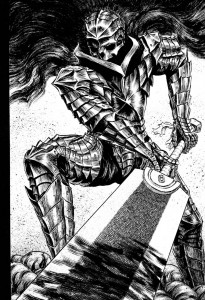


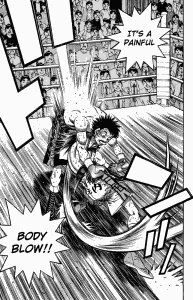
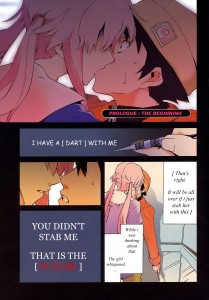




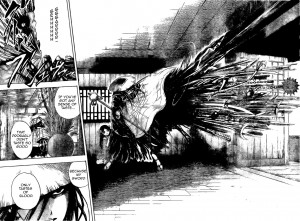
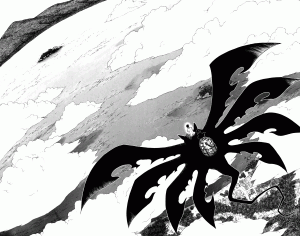





![[otakami]Hoshi_no_Samidare_Ch30_011](http://www.templeofmick.com/blogw/wp-content/uploads/2011/02/otakamiHoshi_no_Samidare_Ch30_011-210x300.jpg)
